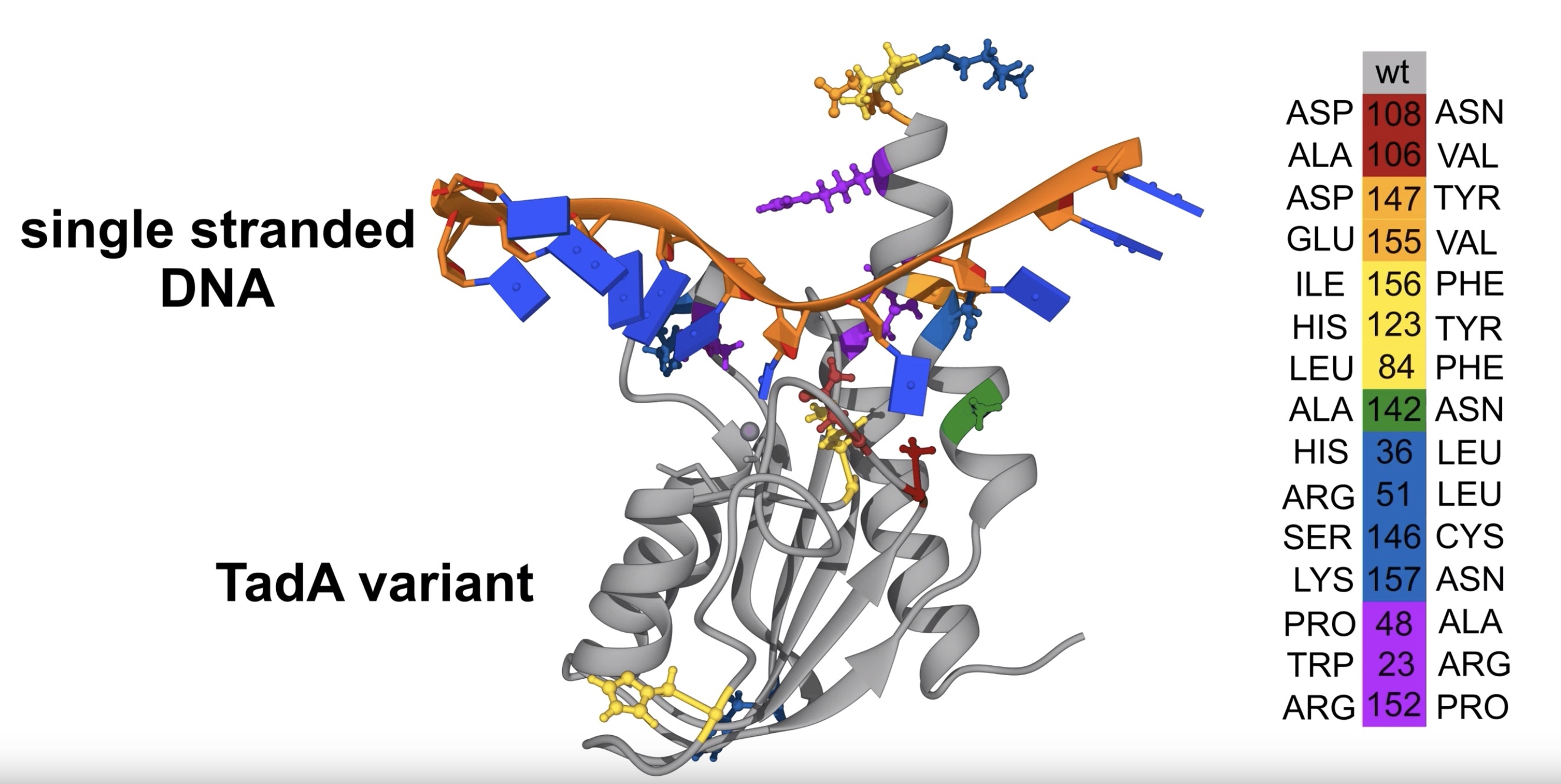The scientists worked with molecular dynamics simulations to explore the structural and functional role played by genetic mutations. Assistant Professor Alexis Komor, Professor Francesco Paesani and Ph.D. student Kartik Rallapalli took the first look at the onset of DNA-editing activity in an RNA-editing enzyme called “TadA” that served as the precursor to a class of base editors known as ABEs.
“The over-arching goal of our study is to understand how evolution works in general—how evolutionary changes at the molecular level can train an existing enzyme to do something completely novel,” said Rallapalli. “By gathering atomistic insights into the process, we may be able to learn the rules of the evolutionary game and try to get ahead of natural evolution—try to convert more RNA-editing enzymes into DNA-editing enzymes, which can become novel genome editors.”
The DNA of all living organisms encodes the genetic information cells need to function properly. Any mutations in this code can lead to a genetic disease. One example is color blindness. Other more harmful genetic diseases include sickle cell anemia, cystic fibrosis and some forms of cancer. Genetic mutations such as these, however, can be cured by scientists with the precision of a gene-editing technology known as base editing.
DNA is made up of four nucleobases which pair-up; typically adenine (A) with thymine (T) and guanine (G) with cytosine (C). With base editing, scientists can apply two classes of the technology to access specific locations in the DNA and swap a faulty base pair with its corrected form. For example, cytosine base editors (CBEs) can be used to convert C→T, and adenine base editors (ABEs), can change A→G. So base editing presents scientists with the potential to cure disease-causing single base mutations in the genome.
Rallapalli, a third-year Ph.D. student in the Paesani Research Group, explained that the base editors consist of two subunits: a catalytically impaired Cas9 subunit (Cas9 nickase) that acts as a DNA-binding module, and the single-stranded DNA (ssDNA)-specific editing enzyme, TadA, that chemically transforms the target A into G.
Highlighting the innovation of fusing Cas9 with an A→G editing enzyme to do chemistry on the genome, Rallapalli also noted the challenge of having a low inventory of enzymes that can perform this type of substitutional chemistry on DNA.
“Adenine that is being targeted is within the genome, which is within the nucleus, which, in turn, is within the cell. Hence, what we are targeting is very tightly guarded. Nature never bothered to have enzymes that could go in there and change things,” she said. “This implies that we have a dearth of naturally occurring enzymes that can perform chemistry on ssDNA. In a sense, this shows how evolution at the molecular level takes a certain biomolecule and changes it to the extent it starts recognizing a new thing.”
According to Rallapalli, while the function of ABEs at the cellular level is known, science still lacks a mechanistic understanding of how the DNA-editing efficiency of ABEs is related to amino acids that compose this enzyme complex.
She noted that in a previous study, Komor evolved TadA into a DNA-editing enzyme by introducing 14 different amino acid changes to its sequence. The team studied the effects of these amino acid changes on the structure and function of TadA, trying to decipher why a single amino acid change is able to trigger drastic effects in the activity of the TadA enzyme.
According to Komor, who is a pioneer in the field of base editing, there are many applications of genome editing in general. She said that her lab at UC San Diego is more interested in introducing the disease relevant point mutations in a cellular model in order to study how these mutations are contributing to diseases, and then actually predicting additional point mutations that can cure these diseases.
“The main thing we did for the development of ABEs was to make huge libraries of TadA variants and pull out the variants that worked. Given the stochastic nature of the evolutionary process that we employed, we had absolutely no idea of how these variants were working,” said Komor. “It’s really hard to study these enzymes inside a cell or even in a test tube. That’s where Kartik came in and provided us with an atomistic understanding of how particular amino acid changes in TadA enable this enzyme to do its chemistry on DNA.”
According to Komor and Paesani, a pioneer in the field of advanced computer simulations, developing models that lead to better understanding of what amino acid changes are needed to enable an enzyme to switch its activity is the crucial insight for advancing the field of genome editing. “This is a very complex problem and requires the creative combination of both computational chemistry methods and biochemical techniques” said Paesani.
“These atomistic insights can focus our actual experimental efforts on certain amino acids, which can significantly reduce the cost and the labor of research and increase our chances of success. We are thrilled to see what more this combination of simulations and experiments can reveal in the future,” said Komor.
This research was supported by the University of California San Diego and the NIH (grant no. 1R21GM135736-01). All computer simulations used resources of the Extreme Science and Engineering Discovery Environment (XSEDE), which is supported by the NSF (grant no. ACI-1548562). The research team used the petascale Comet supercomputer, based at the San Diego Supercomputer Center (SDSC) on the UC San Diego campus, to create the simulations. Access to Comet was provided via the XSEDE program. SDSC Director Michael Norman extended the allocation, allowing the team more time to complete the simulations. The manuscript was written through contributions of all authors.
Original post https://alertarticles.info


